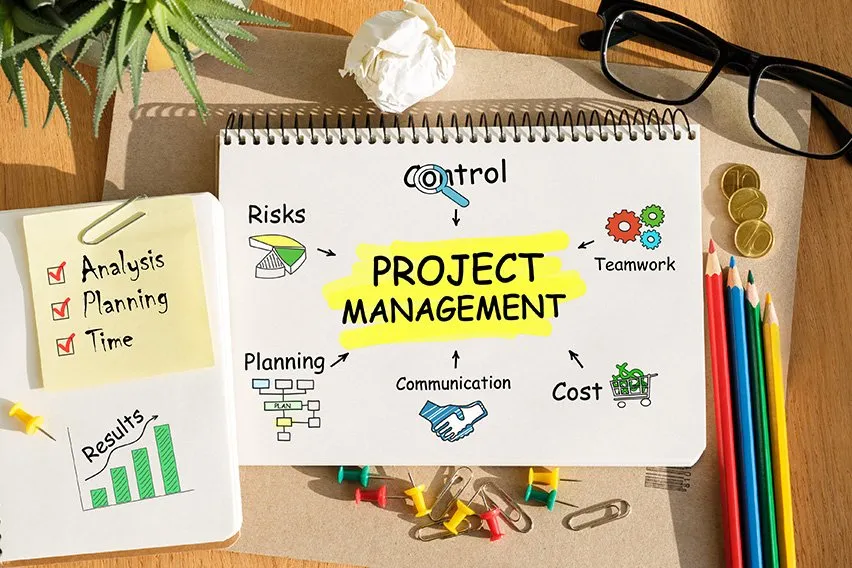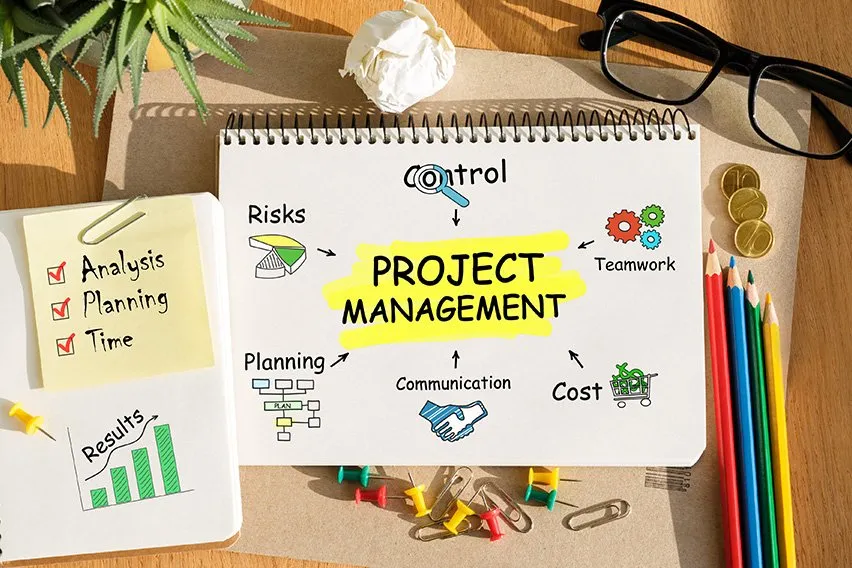How to Project Manage?

Project managers are hired to launch and keep a project on track until completion. Making sure everything runs smoothly and collaborating with team members and the client can be stressful if you don’t properly manage and plan the project.
Here are some things to consider when starting a project:
- How do I get started?
- What are the necessary steps to move the project from initiation to closure?
- How do I build the right team to get the job done?
- Who do I ask for help in this process?
The project management process helps anyone leading a project, committee or team initiative for an organization. Whether you are organizing a small office party or leading a new product development initiative, project management tools and processes exist to make your success rate higher.
Here are the five stages of the Project Process:
- Initiation: starting off the project.
- Planning: making a plan for all the work involved in the project.
- Execution: completing the task involved to successfully complete the project.
- Managing and controlling: monitoring the progress of the project by keeping an eye on the work being done.
- Closing: completing and delivering the project and adjourning the team.
Proper project management can ensure that the purpose, vision and goals of a project are met while supporting the audience’s objectives. It helps you avoid risks and effectively and efficiently use available resources. Additionally, it helps team members understand their responsibilities, the deliverables expected and the schedule the need to follow to complete the project on time and within budget.

This article will also discuss:
Basic of Project Management Tips
Basic of Project Management Tips
Now that you’re on way to managing a project, here are a few tips to help you manage your project to completion.
Define the Scope
The first and most important step in any project is defining the scope of the project. What is the project objective? What are you supposed to accomplish and create? It is as equally important to know what is not included in your scope. Get your boss to clearly define the scope of the project, if you are confused by any of the assigned objectives.
You might be tasked to plan a corporate social function. The scope of the project would be organizing a reception for 100 guests complete with dinner, open bar and entertainment by a certain date at a cost not exceeding $20,000.
Determine Available Resources
You will have to deal with management to make sure you have the people, equipment and money available to achieve the project objectives. As a project manager, you won’t have direct control of these resources, but you can talk to your direct manager about it.
Understand the Timeline
As a project manager, knowing when a project needs to be completed is essential to your planning process. As you develop your project plan you might find that you have some flexibility with how you use your time during a project. However, some deadlines – like event deadlines – are fixed. If you decide to use overtime hours to meet your schedule, you must weigh those hours against what you can afford within your budget.
Assemble Your Team
Your team is made up with technical experts chosen to complete the project at hand. Getting your team together will help you start a dialog about the next steps and any concerns they might have. Their functional manager assigned them to the team and your job is to manage this team.
Detail the Work
What major pieces or components need to be created to complete the project? Each larger item can be broken down into additional tasks. Work with your team members to clarify out the details necessary to achieve each small task and large component. The person in charge of each task must make decisions based on what the options are, the cost and limitations. Under each large component of a project, list smaller tasks that help achieve the large component. How deep you go depends on the size and complexity of the project you are working on.
Develop a Preliminary Plan
A great way to start assembling your plan is to use a precedence table to identify what tasks need to happen before another task can proceed. Formal project management planning includes the practice of developing a network diagram and identifying a critical path. If you are new to project management, these terms might be unfamiliar to you. Basically, the core idea is to sequence the activities in the right order and then allocating resources for those activities.
Questions to ask include:
- What happens first?
- What happens next?
- Which steps can happen at the same time using different resources?
- How long will it take?
There are a lot of excellent software options that will automate a lot of these details for you. Ask fellow project managers what they use.
Create A Baseline Plan
Get feedback on your preliminary plan from your team and other stakeholders. With this feedback, adjust your timelines and work schedules to fit the project into the available time. Apply these changes to the preliminary plan to produce your baseline plan.
Reject Project Adjustments
Usually, there is never enough time, money and talent assigned to a project. As a project manager, your job is to do more with the limited resources than people expect. However, these restrictions might simply be unrealistic. In these cases, you need to make your case and present it your boss to request the unrealistic limits to be changed. If you can anticipate the problems ahead of time, you can ask for your changes at the beginning of the project. This will save you time and money compared to what would happen if you asked for these changes later in the project.
Work Through Your Plan But Don’t Die For It
While making a plan is important, it is also important to be prepared to change your plan if necessary. If one part of your plan is blocked by an accident, you need to change your plan and go a different way. Do the same with your project plan. Change things as needed but always keep the scope and resources.

Monitor Progress
Set everyone on your team with their expectations at the beginning of the project. After that, check in regularly to see their progress and to check if anything is getting in their way. This will make it easier to catch issues before they become a problem.
Document Everything
Make sure you keep a paper trail and records of all the work you do. Every time you change your baseline, write down what the change was and why it was necessary. When you have a new requirement is added to a project write down where the requirement came from and how it impacts the timeline and budget. You won’t be able to remember everything, so writing it down helps you to look at everything at the end of the project so that you can learn from them and answer questions from managers.
Keep Your Team Informed
Let all your project stakeholder know your project progression along the way. Let them know of your successes as you complete each milestone. Make sure to also inform them about problems as soon as they come up. Keep your team informed along the way too, so they can consider how changes being made will impact their tasks. Make sure everyone on the team knows how other people on their team is doing, in case they need to pitch in.
What Is a Successful Project?
Successful projects are those that meet business requirements, delivered and maintained on schedule and on budget, and deliver the expected business value and return on investment.
RELATED ARTICLES

 What Are the Project Management Processes?
What Are the Project Management Processes? Why Is Project Management Important? Because It Provides a Detailed Plan
Why Is Project Management Important? Because It Provides a Detailed Plan 16 Tips on How To Organize a Business
16 Tips on How To Organize a Business Improve the Efficiency of Your Employees: 10 Proven Tips for Small Businesses
Improve the Efficiency of Your Employees: 10 Proven Tips for Small Businesses 15 Hacks for Improving Efficiency in the Workplace
15 Hacks for Improving Efficiency in the Workplace 7 Proven and Budget-Friendly Ideas to Improve Your Small Business
7 Proven and Budget-Friendly Ideas to Improve Your Small Business